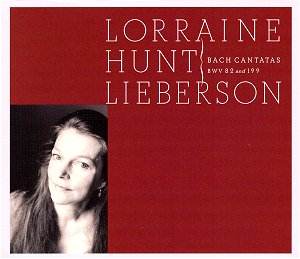The two cantatas on
this disc belong to the most famous
and most performed and recorded. Cantata
82 is in particular renowned for its
second aria, 'Schlummert ein, ihr matten
Augen'. Bach's second wife, Anna Magdalena,
must have loved the aria. She included
a version for solo voice and b.c. -
with the preceding recitative - in her
second Clavierbüchlein. Bach composed
this cantata in 1727 for bass, oboe,
strings and b.c. He reworked it three
times: 1730 or 1731 for soprano and
transverse flute, 1735 for mezzo-soprano
and oboe and in 1745 or 1748 for bass
again, this time with oboe da caccia.
The second cantata,
BWV 199, is one of Bach's earliest works,
and dates from 1714, when Bach was employed
in Weimar. It is scored for soprano,
oboe, strings and b.c. Remarkable is
the fact that - with the exception of
one very short recitative (nr 5) - all
recitatives are 'recitativi accompagnati',
in which the solo voice is accompanied
by strings and b.c. It contains one
chorale, which is sung by the soloist,
with a solo part for the viola, and
accompanied by basso continuo.
I don't think there
are many recordings which combine these
two cantatas, performed by the same
singer. The version of Cantata 82 here
is the one for mezzo-soprano, of course,
but Cantata 199 is for soprano. Originally
it was intended to be sung at high pitch.
The organ in Weimar was tuned at 'Cornet-ton',
in which the a'=ca 465 Hz. Lorraine
Hunt Lieberson is only able to perform
it, because here the modern standard
pitch is used, with a'=440 Hz. Even
so her voice does sound stressed at
some high notes.
The orchestra uses
modern instruments. That doesn't make
it impossible to apply some of the insights
of the historical performance practice.
There are some hints that this is the
case here - the dynamic differentiation
and the articulation in the strings
in the first aria of Cantata 82, for
instance. But on the whole this is a
pretty old-fashioned interpretation.
For some this will come as a relief.
But I don't like it. So let me sum up
what is wrong with it, in my view.
The singer uses too
much vibrato and so does the oboist.
(She uses an oboe d'amore, for which
I can't find any explanation in the
booklet.)
What is worse: Lorraine
Hunt Lieberson ignores the word accents
in the text. The main means of expression
she uses are tempo and volume. But it
has more to do with creating an atmosphere
than with expressing the text.
The players are doing
basically the same. The oboist plays
legato almost all the time, and so does
the violist in the chorale "Ich, dein
betrübtes Kind". But in vocal music
of the baroque the instrumentalists
have to express the text just like the
singer(s).
The strings sometimes
produce a thick sound which one associates
with traditional symphony orchestras.
That is the case in particular in the
aria ‘Tief gebückt und voller Reue’
from Cantata 199.
In a number of cases
the character of the music is completely
missed. For example, the aria 'Schlummert
ein, ihr matten Augen' (BWV 82,3) is
a lullaby, but it is very unlikely that
anybody will be lulled by this performance,
except from boredom. The last aria of
Cantata 199, 'Wie freudig ist mein Herz',
is a gigue. Here the playing is rather
stiff and hardly suitable to express
the joy the aria is about.
The tempi are often
unsatisfying. The aria ‘Tief gebückt’
is not a very sad piece, in contrast
to what one would expect. It is, as
Michael Steinberg writes in the liner
notes, as if "the sinner felt relief
after the confession of her guilt" (in
the preceding recitative). The key of
E flat reflects this character. But
the tempo here is far too slow. And
when the B part ends with a short passage
with the tempo indication 'adagio',
the music almost comes to a standstill.
The disc ends with
the closing aria of Cantata 199, saying
(in translation) "How joyful is my heart".
After having listened to this recording,
mine wasn't.
Johan van Veen


